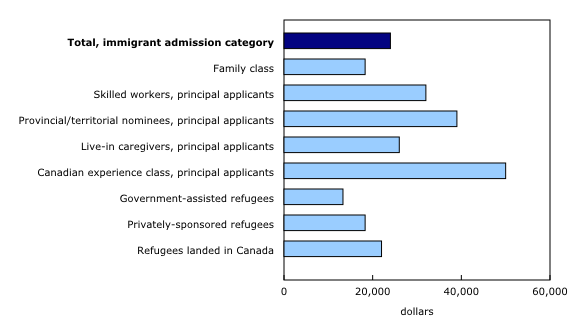Income and mobility of immigrants, 2014
Archived Content
Information identified as archived is provided for reference, research or recordkeeping purposes. It is not subject to the Government of Canada Web Standards and has not been altered or updated since it was archived. Please "contact us" to request a format other than those available.
Released: 2016-12-12
One year after immigration, the median employment income of immigrant taxfilers who landed in Canada in 2013 was $22,000. In comparison, the median income for those who landed in 2011 or 2012 was $21,000 one year after landing in Canada.
Employment income increases over time since landing in Canada
The median employment income of immigrant taxfilers who landed in 2004 was estimated at $16,800 in 2005 (one year after landing). For the same cohort, with more time spent in Canada, it increased to $26,000 in 2009 and rose to $33,000 in 2014.
The median earnings of refugees were lower than those of non-refugees but they also rose over time. The 2004 cohort of refugees earned a median income of $14,700 one year after landing, $18,800 five years after landing, and $24,000 in 2014, ten years after landing.
Principal applicants in the economic immigrant admission categories have higher employment incomes
Employment incomes vary by the category through which immigrants were admitted.
Immigrant taxfilers who landed in Canada between 2009 and 2014 as principal applicants under the Canadian experience class admission category earned the most in 2014 among groups admitted in these landing years. Their median employment income was $50,000. For the same cohorts of provincial and territorial nominees, the median employment income was $39,000. By comparison, the median employment income of all taxfiling immigrants who landed between 2009 and 2014 was $24,000.
Immigrants with pre-landing experience in Canada have higher employment incomes
Of all immigrant taxfilers who landed in 2014, 45% were previously international students, foreign workers, refugee claimants, or held a temporary residence permit. For those who landed in 2013, this proportion was 36%. Immigrant taxfilers who landed between 1980 and 2014 with pre-landing experience in Canada earned an estimated median employment income of $37,000 in 2014. This was 16% higher than of those without pre-landing experience in Canada, who earned $32,000 in the same year.
Immigrants are more likely to remain in Alberta and Ontario but leave the Atlantic provinces
In 2014, 87% of immigrant taxfilers who landed three years earlier filed taxes in the province where they had landed. The proportions were the highest in Alberta (92%) and Ontario (91%). The Atlantic provinces had lower retention at 53%. The rates were over 80% in British Columbia (88%), Saskatchewan (84%), Quebec (83%) and Manitoba (82%).
Note to readers
The Longitudinal Immigration Database combines linked administrative immigration and tax data files. It provides detailed and reliable information on socioeconomic outcomes of immigrants after landing, such as employment income and mobility. It connects short- and long-term outcomes with characteristics at admission, such as immigrant admission category, source country and knowledge of official languages. The database also provides information on pre-admission experience in Canada.
The database combines an administrative Landing File with the T1 Family File through exact matching record linkage techniques. The overall linkage rate is approximately 89%. The population includes immigrants who landed between 1980 and 2014 and who filed taxes at least once between 1982 and 2014.
Immigrant taxfilers are immigrants who filed taxes in a given year.
The province of landing is the province of intended destination or intended landing.
Refugee categories include immigrants who were granted permanent resident status on the basis of a well-founded fear of returning to their home country. These include government-assisted refugees, privately-sponsored refugees, refugees landed in Canada, and their dependents.
Economic immigrant admission categories include immigrants who have been selected for their ability to contribute to Canada's economy through their ability to meet labour market needs, to own and manage or to build a business, to make a substantial investment, to create their own employment or to meet specific provincial or territorial labour market needs.
The Canadian experience class category includes immigrants who have been selected by the federal government and were granted permanent resident status on the basis of their Canadian work experience.
The provincial and territorial nominees category includes immigrants who have been nominated by a province or territory for their ability to contribute to the local economy and meet specific labour market and economic development needs.
For a more detailed description of immigrant admission categories, consult the Help centre page of the Immigration, Refugees and Citizenship Canada website.
This release analyzes income on the basis of medians of employment income (for the population with employment income). The median is the level of income at which half of the immigrant taxfilers have higher income and half have lower. Mean income and other income types (self-employment income, investment income, Employment Insurance benefits and social welfare benefits) are provided in CANSIM. All income estimates are expressed in 2014 constant dollars to factor in inflation and enable comparisons across time in real terms.
CANSIM tables at the provincial level will be released in February 2017.
Products
The Longitudinal Immigration Database 2014 is now available upon request.
Contact information
For more information, contact us (toll-free 1-800-263-1136; 514-283-8300; STATCAN.infostats-infostats.STATCAN@canada.ca).
To enquire about the concepts, methods or data quality of this release, contact Scott McLeish (613-854-8340; scott.mcleish@canada.ca), Social and Aboriginal Statistics Division.
- Date modified:


